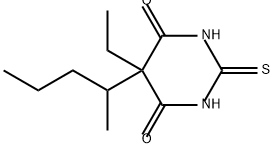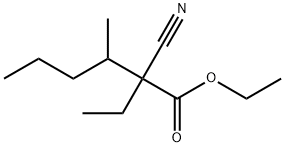Chemical Properties
Off-White Solid
Originator
Pentothal,Abbott
Uses
A thio-derivative of Barbituric acid. Controlled substance (depressant). Anesthetic
Definition
ChEBI: Thiopental is a barbiturate, the structure of which is that of 2-thiobarbituric acid substituted at C-5 by ethyl and sec-pentyl groups. It has a role as an anticonvulsant, a sedative, an environmental contaminant, a xenobiotic, a drug allergen and an intravenous anaesthetic. It is functionally related to a 2-thiobarbituric acid. It is a conjugate acid of a thiopental(1-).
Manufacturing Process
130 g of ethyl (1-methylbutyl) malonic ester is added to a concentrated
solution of sodium ethylate prepared from 34 g of sodium in absolute alcohol;
with stirring, 60 g of finely divided thiourea is added, and, the mixture
refluxed for 10 hours. Most or all of the solvent is evaporated and the residual
mass is dissolved in cold water. The barbituric acid derivative so formed is
precipitated by the addition of dilute hydrochloric acid. It may be 1 purified by
solution in dilute ammonium hydroxide solution and precipitated by carbon
dioxide, followed by recrystallization from 95% alcohol. The ethyl (1-
methylbutyl)thiobarbituric acid so obtained is a white crystalline solid, melting
at 158-159°C and readily forming salts with alkalies.
brand name
Thiopental is BAN.
Therapeutic Function
Narcotic analgesic, Anesthetic
Safety Profile
Poison by intraperitoneal, intravenous, and rectal routes. Moderately toxic by ingestion. An experimental teratogen. Human mutation data reported. A short-acting intravenous anesthetic. When heated to decomposition it emits very toxic fumes of NOx and SOx



